It’s time for another installment of Lost in the Arcade, and this time we’re going to be looking at some of Taito’s offerings. Most of the following games never made it to consoles during the 16-bit console era, and those few that did were import-only, arriving on the Super Famicom or the PC-Engine. Truly, Genesis gamers missed out on what could have been some great home ports. Granted, the company had a lot on its plate at the time, and these arcade-only titles were probably left behind due to the limited amount of releases Taito could port at one time. Even so, they’re still some quality games that should be played to enjoy them for what they are, as well as for what they possibly could have brought to our favorite console.
Now, on to the games!
AquaJack
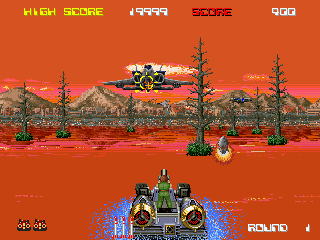 Look! It’s Taito’s Space Harrier! Well, maybe not, but it sure does play pretty much like it. As the crew of a swift boat-type craft, you and your partner will take out jets, destroyers, helicopters, and anything else the enemy can toss at you. Who is the enemy, and why are you fighting? Who cares! It’s all about the destruction here, and AquaJack does a pretty darn good job of keeping you on your toes. Control is a breeze, as all you do is aim, shoot, and jump; and there’s practically no learning curve involved. I could have definitely seen this one on the stock Genesis, and those who have played the aforementioned Sega classic or Nuvision’s Bimini Run might agree. The scaling was nothing the Genesis couldn’t have handled, and the graphics were average at most. This could have been a quick and clean port, adding another quality title to Taito’s line up, but probably got passed over due to the sheer amount of games the company had ready for Sega’s little wonder.
Look! It’s Taito’s Space Harrier! Well, maybe not, but it sure does play pretty much like it. As the crew of a swift boat-type craft, you and your partner will take out jets, destroyers, helicopters, and anything else the enemy can toss at you. Who is the enemy, and why are you fighting? Who cares! It’s all about the destruction here, and AquaJack does a pretty darn good job of keeping you on your toes. Control is a breeze, as all you do is aim, shoot, and jump; and there’s practically no learning curve involved. I could have definitely seen this one on the stock Genesis, and those who have played the aforementioned Sega classic or Nuvision’s Bimini Run might agree. The scaling was nothing the Genesis couldn’t have handled, and the graphics were average at most. This could have been a quick and clean port, adding another quality title to Taito’s line up, but probably got passed over due to the sheer amount of games the company had ready for Sega’s little wonder.
Bonze Adventure
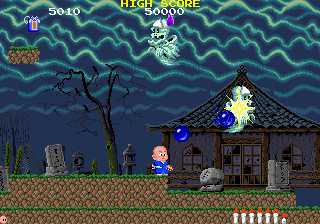 Coming out of left field is Bonze Adventure, a game reminiscent in gameplay of Wardner or even the immortal Ghouls ‘N Ghosts. As a Buddhist monk out to free the Goddess Emma from an evil spirit possessing her, Bonze travels to different lands, battling enemies and collecting power ups. Ghosts in all forms are out to stop him, and he luckily has a ton of different weapon types (all in the form of power orbs) to defend himself. The whole of the adventure is divided into areas, just like Ghouls ‘N Ghosts, and Bonze does everything from climb to paddle a row boat through enemy-infested caves. The gameplay is super simple to learn, and the graphical style kind of jumps out at you without flashing any special effects or showing off the hardware. The Genesis could have easily done this one, and I would honestly have rather Taito have brought us Bonze Adventure that some of the other games it released (hey, Growl, where ya going?). This nice arcade platformer would have been a great alternative to Alex Kidd during the first year of the Genesis, which had more shmups than anything else. Though it was relegated to only a Japanese release on the PC-Engine, it should still be pretty accessible. The language barrier is not a problem at all.
Coming out of left field is Bonze Adventure, a game reminiscent in gameplay of Wardner or even the immortal Ghouls ‘N Ghosts. As a Buddhist monk out to free the Goddess Emma from an evil spirit possessing her, Bonze travels to different lands, battling enemies and collecting power ups. Ghosts in all forms are out to stop him, and he luckily has a ton of different weapon types (all in the form of power orbs) to defend himself. The whole of the adventure is divided into areas, just like Ghouls ‘N Ghosts, and Bonze does everything from climb to paddle a row boat through enemy-infested caves. The gameplay is super simple to learn, and the graphical style kind of jumps out at you without flashing any special effects or showing off the hardware. The Genesis could have easily done this one, and I would honestly have rather Taito have brought us Bonze Adventure that some of the other games it released (hey, Growl, where ya going?). This nice arcade platformer would have been a great alternative to Alex Kidd during the first year of the Genesis, which had more shmups than anything else. Though it was relegated to only a Japanese release on the PC-Engine, it should still be pretty accessible. The language barrier is not a problem at all.
Cameltry
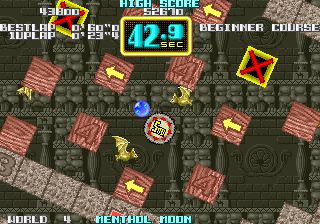 Simple, yet highly addictive. That’s about as much as can be said about Cameltry. No, wait…it’s incredibly addictive. Any doubt about where Sonic Team’s inspiration for the original Sonic The Hedgehog‘s bonus stages came from can now be put to rest, as they almost certainly had to have been influenced by this great and underrated gem. Cameltry goes way beyond simply maneuvering the ball around a rotating maze, and incorporates some cool elements that really add to the challenge. You can make your ball jump and break blocks to move forward, and there are also several obstacles that sap away at your time limit. Charging your jump also adds to the ball’s bounce, so it’s important to measure how much power is needed.
Simple, yet highly addictive. That’s about as much as can be said about Cameltry. No, wait…it’s incredibly addictive. Any doubt about where Sonic Team’s inspiration for the original Sonic The Hedgehog‘s bonus stages came from can now be put to rest, as they almost certainly had to have been influenced by this great and underrated gem. Cameltry goes way beyond simply maneuvering the ball around a rotating maze, and incorporates some cool elements that really add to the challenge. You can make your ball jump and break blocks to move forward, and there are also several obstacles that sap away at your time limit. Charging your jump also adds to the ball’s bounce, so it’s important to measure how much power is needed.
Cameltry would have worked so well on the Genesis, and it would have complimented Ultimate Qix in the console’s solid puzzle line up. Given how well Sonic‘s bonus stages worked, I’m sure Taito could have done the game the justice it deserved. They could have also ported it to the Sega CD, whose biaxial rotation features were tailor-made for this sort of game. As it is, Cameltry was releasd on the SNES as On the Ball, which may have caused some potential fans to pass it over as another game. A sequel recently came out on the Nintendo DS, so at least the franchise is alive and well.
Dungeon Magic
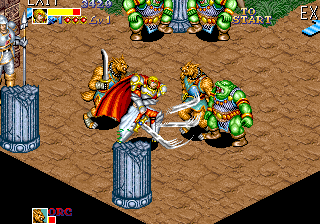 I think someone over at Taito saw Capcom’s Dungeons & Dragons: Tower of Doom and got jealous. Dungeon Magic bear more than a passing resemblance to that arcade smash in appearance, but manages to be different enough as to warrant playing. This isn’t just another “me too” copycat of the era, there’s some depth here, especially when you play it with three friends. Interestingly enough, it plays more like an isometric Final Fight than D&D, with lots of body slams for vanquishing foes and weapons to pick up. Choose from Ash the knight, Gren the fighter, Cisty the Elf, or Vold the magic user; and set out to rescue the princess before she’s sacrificed to the evil demon. Yes, the plot is simply horrific, I know, but the gameplay more than makes up for it. Your characters can perform charge and dash attacks, and just about everything in the environments can either be picked up and thrown or destroyed to reveal goodies.
I think someone over at Taito saw Capcom’s Dungeons & Dragons: Tower of Doom and got jealous. Dungeon Magic bear more than a passing resemblance to that arcade smash in appearance, but manages to be different enough as to warrant playing. This isn’t just another “me too” copycat of the era, there’s some depth here, especially when you play it with three friends. Interestingly enough, it plays more like an isometric Final Fight than D&D, with lots of body slams for vanquishing foes and weapons to pick up. Choose from Ash the knight, Gren the fighter, Cisty the Elf, or Vold the magic user; and set out to rescue the princess before she’s sacrificed to the evil demon. Yes, the plot is simply horrific, I know, but the gameplay more than makes up for it. Your characters can perform charge and dash attacks, and just about everything in the environments can either be picked up and thrown or destroyed to reveal goodies.
Dungeon Magic would have fit so well on the Genesis or even the Sega CD. Some color would have been lost, and the sprite sizes would have perhaps been reduced, but it could have been done. This is a fun little adventure/brawler that would have stood out, as there are woefully few of them on the console.
Extermination
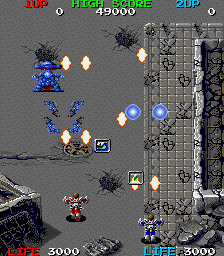 No, it’s not Undead Line, though I do admit there is a striking similarity in the visuals (Extermination came out first though). As the only shmup-like game on this list, I’ve included it because it does something a bit different from its brethren. Instead of shooting enemies for power ups, you shoot them for life points! Each enemy releases a little orb that adds to your life total, and the only way to maintain yourself alive for any significant amount of time is to kill everything in sight! Power ups are indeed available, but are hidden in caves that you must find by shooting the local fauna. This means that you’ll spend as much time looking for the items as using them, and Taito’s made even the acquisition of these goodies something of a challenge. When you initially enter the hidden rooms, there are no enemies present. Take too long, however, and little green worms swarm in at you!
No, it’s not Undead Line, though I do admit there is a striking similarity in the visuals (Extermination came out first though). As the only shmup-like game on this list, I’ve included it because it does something a bit different from its brethren. Instead of shooting enemies for power ups, you shoot them for life points! Each enemy releases a little orb that adds to your life total, and the only way to maintain yourself alive for any significant amount of time is to kill everything in sight! Power ups are indeed available, but are hidden in caves that you must find by shooting the local fauna. This means that you’ll spend as much time looking for the items as using them, and Taito’s made even the acquisition of these goodies something of a challenge. When you initially enter the hidden rooms, there are no enemies present. Take too long, however, and little green worms swarm in at you!
Yeah, Extermination doesn’t really do anything remarkable, but what it does it does well. I can only guess that it was never released on the Genesis or SNES due to its age (it was released in 1987), and considering that it’s not exactly a marquee title, Taito decided to go with newer games for its home line up.
Gladiator
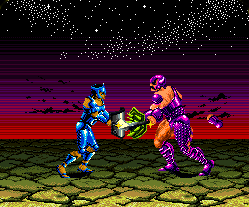 Thinking back to around when the Genesis launched, and you’ll be loathe to find any fighting games. Heck, about the best you’ll do is Last Battle and Sword of Sodan. Not the best of company, to be sure. This major gap could have been nicely filled by Gladiator. No, it’s not the prettiest fighter, and it looks downright stiff sometimes, but back in 1989-1990, it would have rocked. Walking along, upgrading your weapons and then hacking the hell out of your rival, sending his armor flying all over the place — I would have had many a sleepless night playing through this one on my Genesis. Quite honestly, there’s nothing about Galdiator that couldn’t have been done on the stock console, and I guess its 1986 release date was its own worst enemy. Home computer owners (Spectrum, Amstrad) enjoyed the hack-‘n-slash goodness, but console owners had to wait until the MAME arrived to get in on the fun.
Thinking back to around when the Genesis launched, and you’ll be loathe to find any fighting games. Heck, about the best you’ll do is Last Battle and Sword of Sodan. Not the best of company, to be sure. This major gap could have been nicely filled by Gladiator. No, it’s not the prettiest fighter, and it looks downright stiff sometimes, but back in 1989-1990, it would have rocked. Walking along, upgrading your weapons and then hacking the hell out of your rival, sending his armor flying all over the place — I would have had many a sleepless night playing through this one on my Genesis. Quite honestly, there’s nothing about Galdiator that couldn’t have been done on the stock console, and I guess its 1986 release date was its own worst enemy. Home computer owners (Spectrum, Amstrad) enjoyed the hack-‘n-slash goodness, but console owners had to wait until the MAME arrived to get in on the fun.
Rambo III
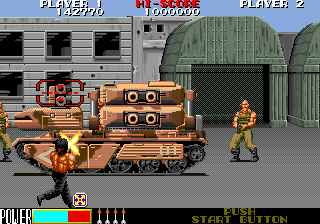 I know Sega released a cool run-‘n-gun shortly after the Genesis launched, but this would have been just as cool. Since we were denied the other two awesome arcade entries of this type: Devastators and G.I. Joe, it would have been nice to at least have had one to call our own. I love the forward-scrolling action, and no one knows how to blow things up like John Rambo! Even cooler is the fact that you could now use Col. Trautman as a second player! I know Rambo III could have made it to the Genesis virtually intact, as Taito’s B System hardware saw a few of its other releases (Rastan Saga, Master of Weapon) brought home in great fashion. Had it been too much for the stock console to handle, well…that’s what the Sega CD was for, wasn’t it? I’m betting that the real culprit was the issue of licensing rights, as the Rambo franchise seems to have been all over the place during this period.
I know Sega released a cool run-‘n-gun shortly after the Genesis launched, but this would have been just as cool. Since we were denied the other two awesome arcade entries of this type: Devastators and G.I. Joe, it would have been nice to at least have had one to call our own. I love the forward-scrolling action, and no one knows how to blow things up like John Rambo! Even cooler is the fact that you could now use Col. Trautman as a second player! I know Rambo III could have made it to the Genesis virtually intact, as Taito’s B System hardware saw a few of its other releases (Rastan Saga, Master of Weapon) brought home in great fashion. Had it been too much for the stock console to handle, well…that’s what the Sega CD was for, wasn’t it? I’m betting that the real culprit was the issue of licensing rights, as the Rambo franchise seems to have been all over the place during this period.
Sel Feena
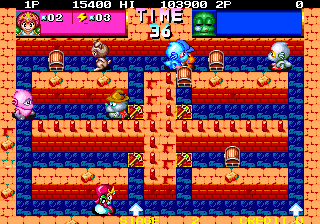 No list would be complete without a cute little Japanese single-screen platformer! Sel Feena plays much along the line of games like Pengo and Crater Maze but unfortunately never made it to the U.S. That’s a shame too, as it’s addictive, quirky, and fun. Throw chests at foes to trap them inside, and then toss the chest onto a key square to release coins for points. Not much too it, as you can see, but it sure does make for a good time! The stages are varied, and there are even bonus areas for you to score extra lives and such (much like Super Mario Bros. 3‘s “pick a chest” bonuses).
No list would be complete without a cute little Japanese single-screen platformer! Sel Feena plays much along the line of games like Pengo and Crater Maze but unfortunately never made it to the U.S. That’s a shame too, as it’s addictive, quirky, and fun. Throw chests at foes to trap them inside, and then toss the chest onto a key square to release coins for points. Not much too it, as you can see, but it sure does make for a good time! The stages are varied, and there are even bonus areas for you to score extra lives and such (much like Super Mario Bros. 3‘s “pick a chest” bonuses).
Considering that Pengo was left in Japan, and this was never ported, I can’t think of any significant U.S. releases of this type in the first few years of the Genesis with the exception of the little-known (and highly underrated) Zoom! Pity, since these games are easily converted and instantly playable. Chalk another one up to the dreaded “limited releases for the year” list.
Silent Dragon
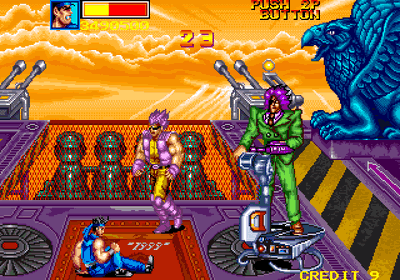 Every list needs at least one beat-’em-up, and as large as Taito’s repertoire may be, there aren’t too many that stand out. Silent Dragon is perhaps at the top of that list and is actually a competent entry in the genre. The three-player simultaneous action is lots of fun, with solid visuals and interesting environments. I do cringe a bit at the character designs, but that can probably be said of most games of these types. Of course, Taito saw fit to include a playable ninja, which was practically a requisite in gaming at the time.
Every list needs at least one beat-’em-up, and as large as Taito’s repertoire may be, there aren’t too many that stand out. Silent Dragon is perhaps at the top of that list and is actually a competent entry in the genre. The three-player simultaneous action is lots of fun, with solid visuals and interesting environments. I do cringe a bit at the character designs, but that can probably be said of most games of these types. Of course, Taito saw fit to include a playable ninja, which was practically a requisite in gaming at the time.
Silent Dragon probably would have taken a pretty big hit visually had it been released on the Genesis. The color palate would have suffered the most, but not much more than any other Taito product on the console. This would have made the most sense as a Sega CD game, which was unlikely due to Taito’s lukewarm support (they didn’t even localize Ninja Warriors, remember?).
Syvalion
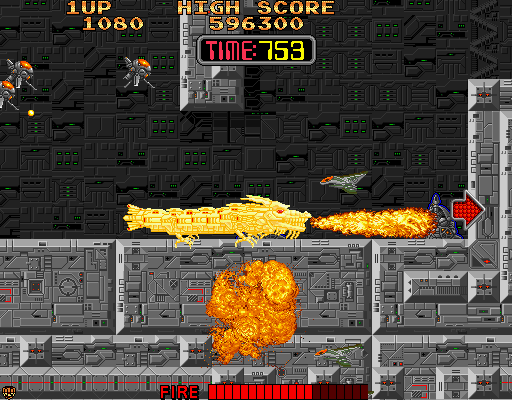 I was quite pleased to see that Syvalion was included in the Taito Legends collection. It’s rather unique, with shmup dynamics that aren’t what you’d typically expect from the genre. Controlling a serpent-like dragon that flies around taking out turrets and enemy craft is about as complicated as it looks, given that said dragon moves very much like a snake. The more hits you take, the shorter you get, gradually overheating until your poor little dragon explodes. The levels are designed to exploit this dynamic to the fullest extent, and the game scrolls in several directions, as opposed to the standard left-to-right of most shumps. It can be quite challenging to get your dragon through a particular stage intact, and once the whole screen begins to flash red, you know the end is near. Not your typical offering, Syvalion would have been a refreshing change to the glut of shmups the Genesis suffered early in its run. Apparently, it appeared on the SNES in both Europe and Japan, so fans should be able to find a copy. It’s a shame though, that we U.S. gamers never got the chance to play it back when it first debuted.
I was quite pleased to see that Syvalion was included in the Taito Legends collection. It’s rather unique, with shmup dynamics that aren’t what you’d typically expect from the genre. Controlling a serpent-like dragon that flies around taking out turrets and enemy craft is about as complicated as it looks, given that said dragon moves very much like a snake. The more hits you take, the shorter you get, gradually overheating until your poor little dragon explodes. The levels are designed to exploit this dynamic to the fullest extent, and the game scrolls in several directions, as opposed to the standard left-to-right of most shumps. It can be quite challenging to get your dragon through a particular stage intact, and once the whole screen begins to flash red, you know the end is near. Not your typical offering, Syvalion would have been a refreshing change to the glut of shmups the Genesis suffered early in its run. Apparently, it appeared on the SNES in both Europe and Japan, so fans should be able to find a copy. It’s a shame though, that we U.S. gamers never got the chance to play it back when it first debuted.
Quite a list, eh? Unfortunate as it is that none of them graced our Genesis, just about all of these gems can be enjoyed on the recently released Taito Legends Vol. 1 and the upcoming Vol. 2. Moreover, all of them are available via MAME, so check them out!

Recent Comments